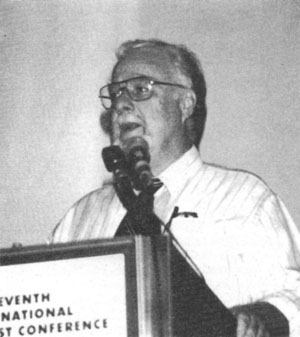Bradley Smith’s “Campus Project” Generates Nationwide Publicity for Holocaust Revisionism
Unprecedented Media Coverage of Holocaust "Open Debate" Campaign
During the past year Bradley Smith – America’s most prominent revisionist activist, and a good friend of the Institute for Historical Review – has succeeded in generatingunprecedented nationwide publicity for Holocaust revisionism as part of his “Campus Project.” Defying a well-organized campaign of threats, intimidation and smears, he and his Committee for Open Debate on the Holocaust (CODOH) have placed more advertisements in student newspapers across the United States than during any other school year. On campus after campus, the ads have provoked enormous publicity, while the resulting furor has generated news reports and commentary in newspapers, magazines and television and radio broadcasts across the country.
Smith had already attracted nationwide notoriety during the 1991–92 school year by placing advertisements or statements calling for open debate on the Holocaust issue in 17 student newspapers, several at major universities. After something of a lapse during the 1992–93 school year – which prompted adversaries to boast that he had been permanently silenced – Smith came back, more effective than ever. During the 1993–94 school year, his ad – the most recent version of which is headed “A Revisionist Challenge to the U.S. Holocaust Memorial Museum” – was published, in one form or another, in at least 35 college and university student papers, as well as in one major metropolitan daily.
Brandeis University Uproar
Nowhere was the reaction to the appearance of Smith’s CODOH advertisement more intense than at Brandeis University (Waltham, Mass.). Hundreds of members of the school’s predominantly Jewish student body rallied to protest the ad, which appeared in the December 7 issue of the weekly Justice. Some 2,000 copies of the student paper were stolen as they were about to be distributed. Two days later, 4,000 replacement copies were delivered under protection of campus police.
Brandeis Professor and Holocaust historian Antony Polonsky told participants at a Dec. 9 campus rally: “Holocaust denial is not a serious scholarly debate. This is a new form of hate propaganda. This is not a First Amendment issue.” Echoing this view was the Boston Globe (editorial, Dec. 14), and Kenneth S. Stern and Jeffrey Ross of the Anti-Defamation League (ADL) in a letter published in The New York Times (Dec. 23).
At a panel discussion on “Holocaust Revision, Holocaust Denial,” Brandeis Professor Jerry Cohen took a somewhat different view. (Justice, Feb. 15) Said Cohen:
To simply stipulate facts and insist upon them with an attitude of ‘I shall not debate, I shall not confront, I shall not discuss lest I give dignity to absurd arguments in a world of absurd arguments’ is, I think, a failed strategy… All historical events are subject to reinterpretation. As we move further and further away from these events, our perspective changes…not only because our interpretation changes, but also because more evidence comes to light.
As a result of his decision to run Smith’s ad, Justice editor David Turner “became a pariah on campus.” His car was defaced, he received hateful phone calls around the clock, and he was threatened with bodily harm. (Time magazine, Dec. 27.)
Queens College Bigotry
The text of the Smith’s ad appeared in the student paper of Queens College (Flushing, New York) along with a barrage of smears and bigoted commentary. The ad text was printed on the front page of the QC Quad, February 21, under the heading “An Illustration of Hate.” (Smith’s check was returned, and the CODOH address was deleted from the ad.)
Right next to Smith’s text appeared a viciously critical front-page editorial entitled “Revising Revisionism,” which told readers that “the Quad wants to warn you that the adjoining material is hazardous to your head.” Page two of this same issue was entirely devoted to a full-page letter from Queens College president Shirley Strum Kenny, which likewise attacked Smith while not citing even a single instance of what she called his “disregard for truth.”
A second Quad editorial in this same issue, headed “A Man and His Lies,” sought to discredit Smith by attributing to him racist statements supposedly made in a 1989 interview with the University of Nebraska Sower. For example, Smith was quoted as expressing concern that America is becoming a “Mexicanized” country. In fact, Smith never made the statements attributed to him by the Quad, and was never even interviewed by the Sower. Smith’s wife of 16 years is an immigrant from Mexico.
Further attacks against Smith appeared on five other pages of this same Feb. 21 issue of the QC Quad, as well as in the two succeeding issues of Feb. 28 and March 7.
All this generated reports and commentary in off-campus media, including a rather detailed article in the Feb. 10 Long Island Newsday, an editorial in the Feb. 12 New York Post, and an item in the Jewish Week of Feb. 18–24. Moreover, Quad executive editor Dave Konig was on hand for the March taping of the “Phil Donahue Show,” on which revisionists Smith and David Cole were guests, when he was permitted by the host to disparage Smith in person.
Humboldt State University
The publication of Smith’s ad in the March 16 issue of the Humboldt State University (Arcata, Calif.) Lumberjack generated letters arguing each side of the issue, which appeared through the April 13 issue. Some of the letters protesting the ad were written by HSU professors, to which geology senior Stephen Tillinghast responded (April 13): “I was disappointed to see these types of letters from professors on campus; surely they see the dangers of intolerance.” The local daily Eureka Times Standard (March 24) also covered the controversy.
Miami University
At Miami University (Coral Gables, Florida), the publication of Smith’s CODOH advertisement in the April 12 issue of The Miami Hurricane set off a furor that received national media attention. A wealthy Jewish businessman – Sanford L. Ziff, founder of the Sunglass Hut chain – was so upset by the ad’s appearance there that he cancelled a scheduled $1 million donation to the school’s Lowe Art Museum expansion project, and a $1 million gift to the school’s Sylvester Cancer Research Center. Ziff reportedly was also having doubts about naming the University in his will as beneficiary for several additional millions of dollars.
Florida’s leading daily, The Miami Herald, devoted considerable attention to the ad controversy at Miami University. (Its coverage began even before the ad appeared in the student paper there.) Reports about the Miami University uproar also appeared in the Palm Beach Post, the St. Petersburg Times, the Tampa Tribune, USA Today (April 13), the New York Post, and The Washington Post.
An Unusual Punishment
At Georgetown University (Washington, DC), Smith’s ad appeared in the student paper, the Georgetown Voice, on October 14. University officials decided to treat publication of the ad as a serious transgression. The University’s media board required the Voice to print an apology and donate the $200 paid for the ad to the federal government’s US Holocaust Memorial Museum. Finally, the board ordered the three paper’s top editors to tour the Holocaust Museum, escorted by a Georgetown professor of theology.
Other Papers
A report on the success of Smith’s CODOH campaign between September and early November appeared in the Nov.–Dec. 1993 Journal (p. 22). In addition to the papers and schools noted in that article and elsewhere in this one, Smith’s ad appeared in student papers at Wright State University (Dayton, Ohio) Oct. 28; Mount Hood Community College (Portland, Ore.), Oct. 29; Roosevelt High School (Portland, Ore.), in October; University of Notre Dame, Nov. 18; Bowling Green University (Ohio), Nov. 18; Boston College, Dec. 6; the University of Maryland, Jan. 27; Pennsylvania State University, Feb. 2; the University of Rhode Island, Feb. 4; California State University at Chico, March 9; San Jose State University, March 9; Humboldt State University (Arcata, Calif.), March 16; American River College (Calif.), March 17; Southern Illinois University at Carbondale, April 7; State University of New York (SUNY) College, Oneonta, April 14; Trenton State University, April 14; Wheaton College (Mass.), April 14; Manhattan College (New York), April 14; State University of New York (SUNY), Buffalo, April 15; State University of New York (SUNY), Binghamton, April 15; Clemson University (South Carolina), April 16; Columbia College (Chicago), April 18; State University of New York (SUNY) College, Potsdam, April 19; Central Florida University, April 20; University of Maine (Orono), April 20; Hofstra University (Hempstead, New York), April 21; and, State University of New York (SUNY), Stony Brook, June 6.
In addition, Smith’s ad also appeared for the first time in a major metropolitan daily, the Portland Oregonian (Oct. 24), the state’s most widely read newspaper.
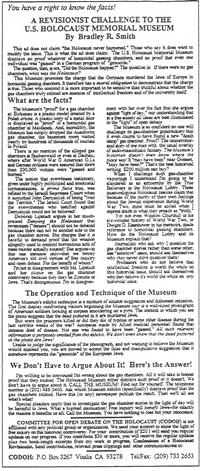
This advertisement (reduced in size) by Bradley Smith's “Committee for Open Debate on the Holocaust” appeared, in one form or another, in at least 35 student papers during the 1993-94 school year. Student editors on these campuses rejected the arguments and pressures of the Anti-Defamation League and other pressure groups, which contend that Americans lack the intelligence and wisdom to make up their own minds about this issue.
Rejection Publicity and Media Distortion
Even where it was turned down, news of the decision to reject Smith’s ad sometimes generated considerable public interest and discussion. At Georgia State University, for example, the editors’ decision to turn down the CODOH ad resulted in pages of commentary, both for and against publication, in the GSU student paper, Signal, between February 22 and April 19. Similarly, the decision to reject the ad by the student paper at the University of Buffalo resulted in a news story in the Buffalo News (April 16).
Another periodical that turned down Smith’s ad was The Skidmore News, a paper that calls itself “the campus authority since 1925,” and is apparently distributed to students at colleges and universities across the country. Nevertheless, this paper devoted an editorial and a 16-page Special Supplement (April 21), entitled “Why are Holocaust deniers targeting college campuses?,” which contained the usual half-truths and smears.
A good example of how The Skidmore News brazenly twisted the truth is this assertion:
Mr. Smith heads up the best-financed and most anti-Semitic propaganda organization in the country, Liberty Lobby. His newsletter published by the Institute for Historical Review is read by thousands across the country.
A Skidmore News essay by Prof. Robert Boyers, while highly critical of Smith and Holocaust revisionism, concluded with a gratifyingly strong support for the principle of free speech and a free press, even on this emotion-laden topic. Wrote Boyers:
I do not observe in the current “revisionist” ad the tenor I associate with a murderous intention…Though it may seem tempting to censor or deny publication to ads that are empty or pointless or otherwise distasteful, many of us would argue that most ads – and many “news” features – are equally distasteful, or misleading, or dangerously manipulative. As long as the paid “revisionist” ads do not contain openly vicious, defamatory or incendiary messages, I would continue to support the decision of college newspapers to publish them.
Gas Chamber Evidence?
Holocaust historian Raul Hilberg, author of The Destruction of the European Jews, was asked by the Skidmore News about evidence “for the existence of [execution] gas chambers” in the German wartime German camps. Hilberg responded by citing the following:
- “Blueprints” from the Auschwitz construction office. In fact, these are clearly blueprints of crematory buildings and morgue rooms;
- “Aerial photography” from Auschwitz in 1944. In reality, these show no evidence whatever of “gassings” or killings of any kind;
- “Collateral documents which speak about the supply of gas.” These are simply records of purchases and deliveries of the commercial pesticide Zyklon B;
- “Remains of these gas chambers,” which were simply crematory buildings and morgue rooms; and,
- “Testimony,” the dubiousness of which every serious historian is aware.
- Finally, Hilberg claimed that “the [German] perpetrators, as a matter of fact, never denied it.” Actually, a wide range of top-level German officials – including Hermann Göring and Albert Speer – strenuously rejected knowing of any wartime extermination program, or of gas chamber killings.
Further Publicity
It was the Brandeis controversy that prompted a full-page Time magazine article (Dec. 27), as well as a nationally distributed Associated Press report (which appeared, for example, in The New York Times, Dec. 12). The slanted Time report included a color photo of Smith at his home in Visalia, California, and a snide reference to the Institute for Historical Review and IHR Journal editor Mark Weber.
Reports also appeared in The Philadelphia Inquirer (Dec. 26), the Philadelphia Jewish Times (Dec. 30), and the College Reporter of Franklin and Marshall College (Jan. 17), although, typically, none of these addressed the specifics of Smith’s ad.
Publication of Smith’s ad in the Georgetown University paper prompted William Buckley to comment in his nationally-syndicated column (published, for example, in National Review, Jan. 24). Buckley, a fixture of New York City’s pro-Zionist neo-conservative circles, dealt sarcastically with Smith and his campaign, and expressed satisfaction with the unusual way the university punished the offending editors.
An essay by Smith appeared as a guest editorial piece in the December 10 issue of the Albany Student Press, published at the State University of New York at Albany. Headlined “The ADL’s Nazi Devil Fantasy,” the essay criticized the Anti-Defamation League for its efforts to suppress open discussion of the Holocaust issue, and particularly tto stop publication of Smith’s CODOH ads. Although this essay angered the campus Jewish Student Coalition, Student Press managing editor Eric Dagnall refused to apologize for running the piece. (Albany Times Union, Jan. 31.)
Smith’s media outreach efforts also led to a front-page article and editorial about him in the February 17 issue of the Collegian, student paper at California State University at Fresno, a letter to the editor in the Chicago Tribune of February 27, a mention in the Cleveland Plain Dealer of April 9, and in several letters to the editor published in the Detroit Free Press, March 16.
Television and Radio Appearances
Smith’s “Campus Project” success brought an invitation to appear on the nationally-televised “Donahue Show.” (For more on this, see the May–June 1994 Journal.) His appearance there led, in turn, to guest appearances by Smith and other CODOH spokesman on several radio talk show programs.
On April 13, Bradley Smith appeared as a guest for an hour on Ft. Meyers, Florida, radio station WINK-AM. Two days later he was interviewed about his campaign for greater public awareness on the Holocaust issue during a 20-minute appearance on ABC Network Radio, which aired over a hundred affiliate stations across the country. On April 18, Smith appeared for one-half hour on WHJJ-AM radio, Providence, Rhode Island.
Friedrich Berg, a member of this Journal’s Editorial Advisory Committee, appeared as a CODOH spokesman for an hour on April 16 as a radio talk show guest on WFTL-AM, Ft. Lauderdale, Florida, and, the next day, for half an hour on WBSM-AM of New Bedford, Conn. On April 19 he was a guest for a full hour on WAFJ-AM, which serves the Decatur-Huntsville area of northern Alabama.
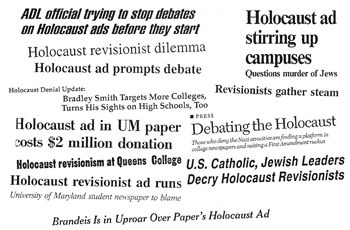
A small sampling of headlines (reduced in size) from the many dozens of newspaper and magazine articles that have appeared during the past year about Smith's campaign to place advertisements in student papers calling for open debate on the Holocaust issue.
Robert Countess
Dr. Robert Countess appeared as a CODOH spokesman on April 11 for an hour as a guest on Chicago radio WVON, a major black-listenership station. His successful presentation, which was hosted by Cliff Kelly, went ahead in spite of demands from some irate Jewish groups in the area that the station cancel the appearance.
Countess, an educator and a member of this Journal’s Editorial Advisory Committee, has proven to be an effective and personable spokesmen for historical revisionism. Last year, for example, he appeared as a spokesman for the Institute for Historical Review on New York City television station WPIX’s half-hour “11 News Close-up” program.
During his seven-minute appearance, which was aired on April 24, 1993, Countess calmly pointed out that there are serious problems with the Holocaust extermination story. He spoke about the fraudulent “confession” of Auschwitz commandant Höss, which was obtained by torture. Countess said that the familiar Six Million figure is a gross exaggeration, and he explained the dreadful conditions in the German camps during the final months of the war. The Holocaust, he said, has become a kind of Jewish racket. Following Countess’ appearance, host Marvin Scott was shown with three other guests who were encouraged to refute the IHR spokesman, including American Jewish Committee official Kenneth Stern (author of the anti-revisionist book, Holocaust Denial).
A Show of His Own
For some years Bradley Smith has appeared as a guest on more than three hundred radio and television talk shows across the nation. Now he has a regularly scheduled radio show of his own. On July 12, Smith’s hour-long show began airing weekly on Providence (Rhode Island) station WALE (AM 990). His show, sponsored by CODOH, is broadcast from noon to 1:00 p.m. every Tuesday. Promotional notices and commercials for Smith’s show are routinely aired throughout the week. Station WALE – on which Smith had already appeared several times as a talk show guest – has the largest radio listenership in the area (which includes Brown University and the University of Rhode Island).
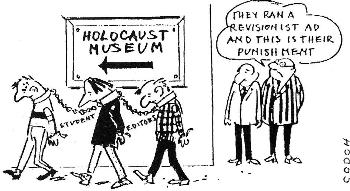
Because they had decided to publish Smith's CODOH ad, three top editors of Georgetown University's “Georgetown Voice” paper were “punished” with a guided tour of the US Holocaust Memorial Council in Washington, DC. This cartoon, distributed by CODOH, comments on the situation.
The ADL Smear Campaign
Smith’s success in reaching students and educators through his ad campaign is all the more remarkable because it has been achieved in spite of a well-financed and -coordinated smear campaign by the Anti-Defamation League (ADL) and other Jewish groups.
Unable to take issue with the content of Smith’s CODOH ad, the ADL attempts instead to castigate Smith as a person, accusing him of the worst sins that anyone can be accused of in today’s America. Typically, the ADL tries to persuade editors that Smith is a “hate monger” with ties to notorious neo-Nazis, who is supposedly promoting a secret neo-Nazi “agenda.” In spite of the ad’s civil and restrained text, the would-be censors continue to characterize it, inaccurately and unfairly, as “Holocaust denial,” “anti-Semitic,” “hate propaganda,” and worse.
In the February-March 1994 issue of the ADL On The Frontline newsletter, the Anti-Defamation League warned:
Smith has had a long time association with the California-based Institute for Historical Review (IHR), America’s leading clearing house for Holocaust denial propaganda. His ad campaign is the centerpiece of the Institute’s long-standing effort to influence America’s youth.
This statement is not entirely inaccurate. As part of its “Media Project,” the IHR is pleased to be able to provide funding for Smith’s outreach work.
As part of the well-financed effort to counter Smith’s campus outreach effort, student newspaper editors are being given expense-paid two-week summer trips to Poland and Israel, a propaganda tour that includes stops at Auschwitz, Krakow, and the former site of the Warsaw Ghetto. (Philadelphia Jewish Times, Feb. 17.)
Jewish groups have succeeded in gaining some non-Jewish support for their anti-revisionist campaign. In March, the Synagogue Council of America and the National Conference of Catholic Bishops issued a “Joint Statement on Dealing with Holocaust Revisionism,” which declared: “All educational institutions and their publications, whether official or student sponsored, should unconditionally reject any efforts to deny the horrifying realities of the Holocaust.”
Heading up the ADL’s anti-Smith campaign is Jeffrey Ross, who worked closely with ADL regional offices and Hillel groups around the country to pressure student papers into rejecting the CODOH ad. Ross told the Philadelphia Jewish Times (Feb. 17) that
The Holocaust deniers are the ideological vanguard of the neo-Nazis, the Ku Klux Klan, Skinheads, white supremacists…Our point is that there is no debate over the Holocaust. There is not more than one position on the existence of the Holocaust. It happened. Period. End of story…Our way of responding to them is not to debate them on their own terms, but rather to expose them for the bigots and neo-Nazis they are.
Ross complained that “the [CODOH] ad in the Brandeis newspaper cost Bradley Smith $130, and he got millions of dollars’ worth of publicity.” Ross claimed to be “surprised” and “saddened” that
Jews on the editorial board want to prove that they are such pure journalists and have such a pure commitment to freedom of speech that they will not allow the fact of their being Jewish to stand in the way of what they consider their duty to the journalistic profession… Therefore, they’re going to decide to publish it.
On another occasion Ross charged (Martyrdom and Resistance, New York, Jan.–Feb. 1994):
The Holocaust-denial campaign is probably the most widespread and effective anti-Semitic campaign since World War II in the United States… The ADL and our colleagues in the Jewish community are expending all of our resources in responding to it.
Confident that Smith’s efforts are no match for its own formidable financial and organizational resources, the Anti-Defamation League boasted in its April-May 1994 On The Frontline newsletter that a “lack of success in Bradley Smith’s current campaign targeting campus newspapers with paid advertisements denying the reality of the Holocaust is testimony to the counteraction efforts of ADL.” While noting that Smith’s ad had appeared in 14 campus publications in the fall 1993 semester, the ADL newsletter asserted that his “current campaign has been much less successful.” Such bragging proved premature. In fact, Smith’s ad campaign overall during the 1993–1994 school year was by far the most successful ever.
‘Jewish Onslaught Against Freedom’
In their effort to keep Smith’s ad from appearing, Jewish groups such as the ADL, and Jewish intellectuals such as Emory University professor Deborah Lipstadt (author of the anti-revisionist polemic Denying the Holocaust), insult American students and educators. In effect, groups such as the ADL arrogantly insist that American students and teachers lack the intelligence and wisdom to make up their own minds about this issue.
The ADL argument that Smith’s ad should not be permitted to appear because it “offends” some Jews is likewise specious and arrogant. Nearly everyone finds at least some advertising “offensive.” And if Holocaust revisionism were really as absurd as the ADL contends, no one need fear that will ever gain any significant acceptance among scholars or the general public.
In an essay published as a guest editorial in the SUNY-Stony Brook Statesman, June 6, Smith castigated the concerted efforts by the groups such as the ADL and Hillel to censor his ads. “What this amounts to,” he aptly pointed out, “is nothing less than a Jewish onslaught against intellectual freedom.” Smith went on to write:
…On every campus in America where there is a substantial number of Jewish students, the Hillel organization (campus arm of the ADL, usually led by a rabbi) leads the attack against free inquiry and open debate on the Holocaust controversy. I am astounded that Jewish intellectuals and scholars stand idly by while the reputation of Jews as free thinkers is everywhere corrupted, diminished and burlesqued by a handful of organized Jewish extremists and censors.
Student editors who are Jewish are under special pressure from the Holocaust lobby to betray their ideals as journalists and to betray as well the long tradition of intellectual liberty for which Jews have worked all over the world. Jewish editors are attacked ferociously, not only by spokespersons for organized Jewry off campus, but also on campus by well-meaning but unsophisticated students egged on by Hillel rabbis who function as semi-professional censors.
Student editors who are not Jewish, while they experience all the above, must face the additional burden of being slandered as “anti-semites” and “haters.” I understand why many are unwilling or even afraid to shoulder the burden that the ideal of a free press places on journalists with regard to the Holocaust controversy.
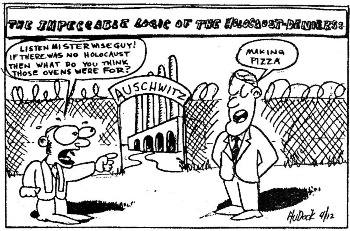
This editorial cartoon commenting on Smith's ad campaign appeared April 12 in “The Miami Hurricane,” student paper at the University of Miami (Florida). Betraying the arrogant ignorance that is all too common of those who learn their history from television and movies, the cartoonist seems to believe that the existence of crematory ovens in German wartime camps is proof of an extermination program.
Impact
More than any other single person, Smith is succeeding in making skeptical discussion of the Holocaust story an established part of America’s social-cultural landscape. While it is difficult to measure, it appears that his CODOH campaign is having a real impact on how students look at European history and American society. Professor Lipstadt now laments that, as a result of the efforts of Smith and other revisionists, “good students come in and ask, ‘How do we know there were gas chambers?’.” (U.S. News and World Report, Feb. 28.)
Smith’s ad campaign, and the furor and publicity it has generated, have done much to raise public awareness about a particular chapter of European history and the issue of free speech. At least as important, the Smith ad campaign is teaching valuable lessons about American social-cultural and political life.
Even for those who may believe that the revisionists are entirely wrong about the historical issues involved here, the frantic and highly emotional nature of the effort to suppress a soberly worded advertisement questioning an aspect of the Holocaust story provides important lessons about political, social and cultural realities in today’s America. For one thing, it teaches that we are expected to show greater sensitivity toward Jewish concerns and interests than to those of any other group, and it points up the almost religious role that the Holocaust story has come to play in American society.
Courage and Devotion
The success of Bradley Smith’s ad campaign is a major defeat for the organized forces of bigotry, and a significant victory for the cause of freedom of speech and greater public awareness of history.
None of the student editors who made the decision to run Smith’s ad have expressed public support for his skeptical view of the Holocaust gas chamber story. Indeed, some expressed animosity toward him for daring to raise the issue. And yet, these editors, some of them Jewish, choose to defy the threats and pleadings of the ADL and Hillel by providing Smith with a forum for his supposedly outrageous views. In doing so, these young men and women have shown greater courage and devotion to the principle of intellectual freedom and a free press than editors of many major metropolitan dailies and television network producers.
Bibliographic information about this document: The Journal of Historical Review, vol. 14, no. 4 (July/August 1994), pp. 18-24
Other contributors to this document: n/a
Editor’s comments: n/a

